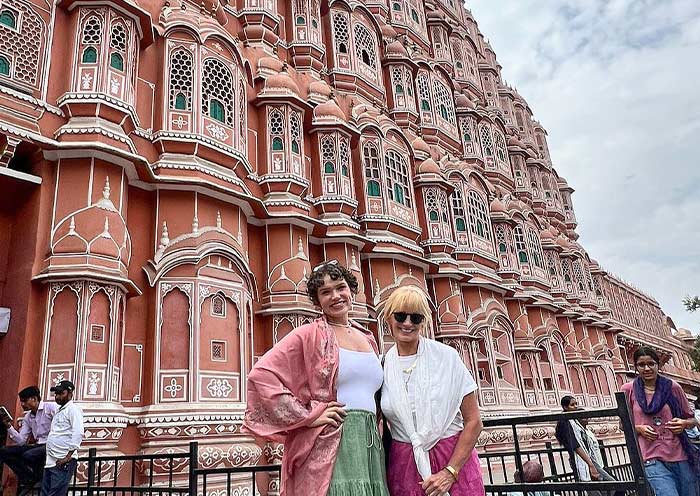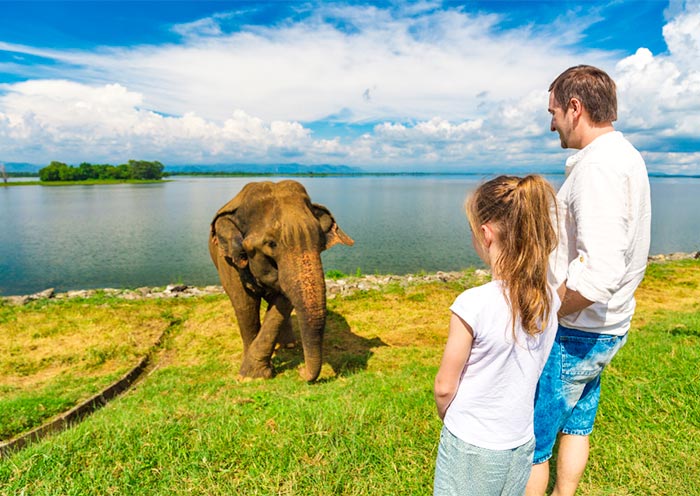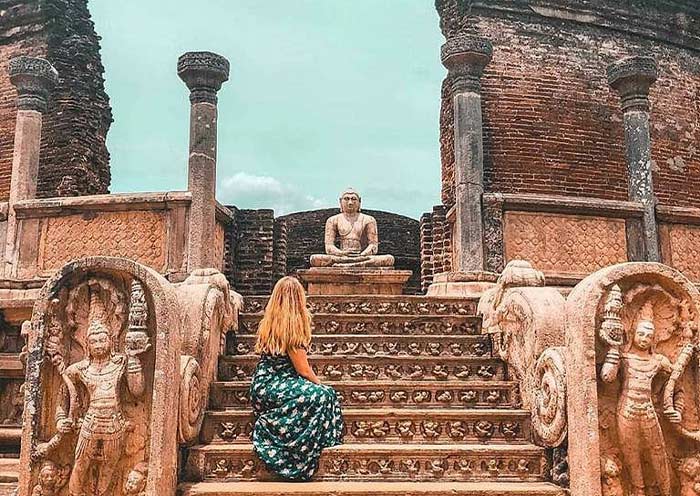Oh, we just got back from the 10-day Sri Lanka tour with Asia Odyssey Travel and it was fantastic! As a mom, I really appreciated how they planned everything so we could enjoy both the fun and educational aspects without any hassle. The kids loved the elephant safari and I was amazed by the beautiful tea gardens we visited. The accommodations were so family-friendly, making bedtime routines a breeze. Honestly, Asia Odyssey thought of everything, making our family trip both relaxing and memorable. Highly recommend it for any family looking for adventure!
15 Days India Sri Lanka Tour: India Golden Triangle & Sri Lanka Highlights
- Highlights
- Itinerary
- Price
- Trip Notes
- Accommodation
- Photos
- Reviews
India's Golden Triangle to Sri Lanka's Idyllic Isles: A 15-Day Tour
India and Sri Lanka, two jewels of South Asia, each hold their unique charm. Our 15 Days India Sri Lanka tour captures the essence of these two nations, weaving from the iconic Golden Triangle of India to key destinations in Sri Lanka. The India to Sri Lank tour promises a vibrant array of experiences, from a rich architectural and artistic tapestry, ancient Buddhist heritage, stunning natural beauty, and biodiversity, to pristine beaches.
India's Golden Triangle (Delhi - Agra - Jaipur)
You'll start in Delhi, a capital city where ancient history and modernity converge. You'll see all the top sights of the old and new city, followed by a jaunt down to Agra, which is home to the iconic Taj Mahal. Witness the sunrise over this epitome of love, explore the grand Agra Fort, and the “Baby Taj” to further complement the city's allure. Continue to Jaipur, where you'll be colored in the hues of the pink city and explore the city's forts and palaces, including the majestic Amer Fort, the elegant City Palace, and the exquisite Hawa Mahal, offering a glimpse into the royal past of India.
Sri Lanka's Best Highlights ( Negombo, Sigiriya, Dambulla, Kandy, Nuwara Eliya, Ella, Yala, Galle, Bentota)
Continue your journey in Colombo, starting with the peaceful beaches of Negombo before ascending the iconic Sigiriya Lion Rock and exploring the spiritual depths of the Dambulla Cave Temple. Journey onwards to Kandy, where the revered Temple of the Tooth Relic awaits. Traverse the verdant tea plantations of Nuwara Eliya and Ella, enjoying one of the world’s most scenic train rides. Encounter Sri Lanka's diverse wildlife at Yala National Park, home to the elusive leopard. Conclude your tour in the historic Galle Fort and unwind on the sun-kissed shores of Bentota.

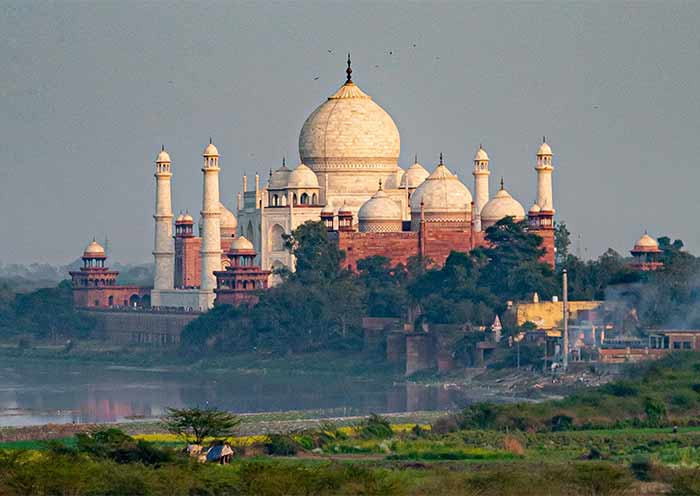
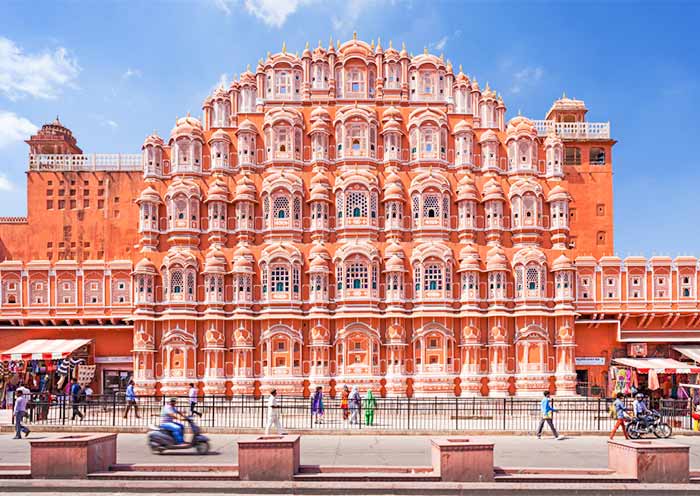
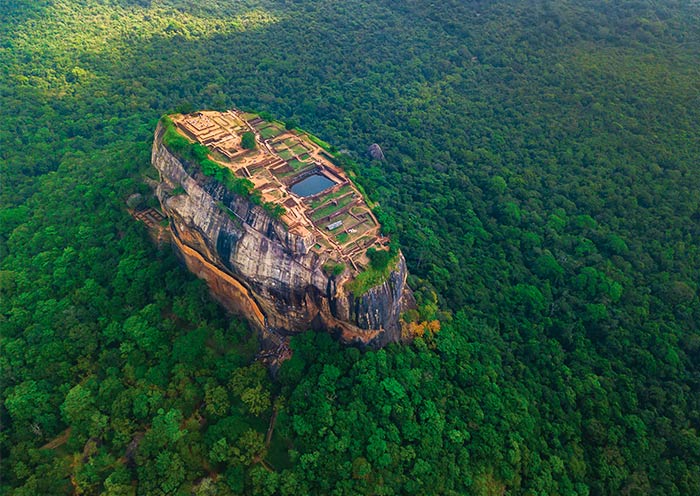
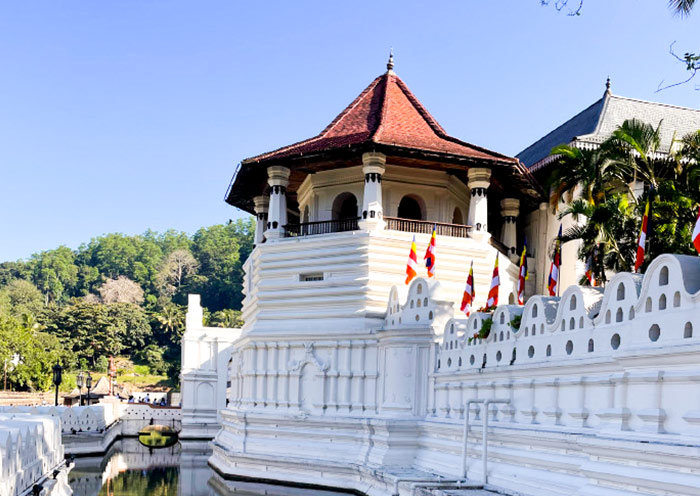



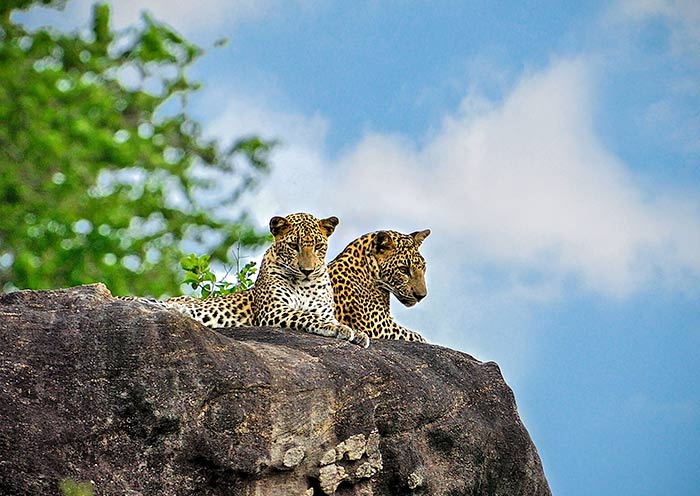

Itinerary at a Glance
Delhi (2 Days)
Jama Masjid, Chandni Chowk, India Gate, Qutub Minar, Humayun's Tomb, Red Fort (outside view)
Agra (2 Days)
Mehtab Bagh, Taj Mahal, Agra Fort, Itmad-ud-Daula's Tomb, Fatehpur Sikri
Jaipur (2 Days)
Amber Fort, City Palace, Jantar Mantar, Hawa Mahal
Jaipur to Delhi (0.5 Day)
Transfer from Jaipur to Delhi for your flight to Colombo, Sri Lanka
Colombo to Negombo (0.5 Day )
Colombo Airport Pick-up, Transfer to Negombo for Accommodation
Negombo to Sigiriya, Sri Lanka (1 Day)
En route: Pinnawala Elephant Orphanagem, Sigiriya Rock Fortress (Lion Rock), Transfer to Dambulla for Accommodation
Dambulla (0.5 Day)
Dambulla Cave Monastery
Dambulla to Kandy (1.5 Days)
En route: Spice Garden, Kandy: Temple of the Tooth, Royal Palace of Kandy, Royal Botanical Garden, Kandy Lake, Kandyan Dance
Nuwara Eliya, Sri Lanka (1.5 Days)
Tea Plantation, Gregory Lake, Horton Plains Hike
Nuwara Eliya to Ella, Sri Lanka (0.5 Day)
Scenic Train Journey to Ella, Nine Arch Bridge
Yala National Park (1 Day)
Yala National Park Jeep Safari
Galle (1 Day)
Galle Dutch Fort, Stilt Fishing
Bentota (1 Day)
Free Time on Bentota Beach
Colombo, Sri Lanka
Airport see-off
Itinerary Day by Day
Welcome to Delhi, the capital city of India! When you arrive at Indira Gandhi International Airport, our local professional guide and driver will pick you up and escort you to the downtown area. After checking in at your hotel, you can relax and decompress from your long flight for the rest of the day.
Delhi is a fascinating metropolis that seamlessly blends the old with the new. Divided into two distinct parts - Old Delhi and New Delhi - the city offers a captivating journey through time, where ancient traditions coexist with modern developments.
Arrival Ideas:
1. Flights to Delhi: Travelers can take international flights to Indira Gandhi International Airport from major cities in Europe (London, Paris, Frankfurt, Amsterdam, Rome), the Middle East (Dubai, Doha, Abu Dhabi), North America (New York, Toronto, Los Angeles), and Asia (Kathmandu, Singapore, Phuket, Istanbul, Kuala Lumpur, Kuwait, Bangkok, Colombo). India domestic flights connect New Delhi with Varanasi (1h 20m), Udaipur (1h 25m), Mumbai (2h), Amritsar (1h 20m), and other destinations.
2. Delhi Airport Transportation: Delhi Airport is located in Palam, about 18km southwest of central Delhi. The airport is well-connected to the city center, with a typical travel time of 30 to 45 minutes by car.
Free Time Ideas (Optional): Red Fort Sound and Light Show (Jai Hind, Evening Show of 60 min)
With a seating arrangement of 700 people for a single viewing, this spectacular evening show brings the history of the Red Fort (World Heritage) and Delhi to life in a fun and engaging way! (Tips: Closed on Mondays. Make sure to book your tickets in advance. Show timings: 6:30 - 7:30 pm in Hindi; 8:15 - 9:15 pm in English).

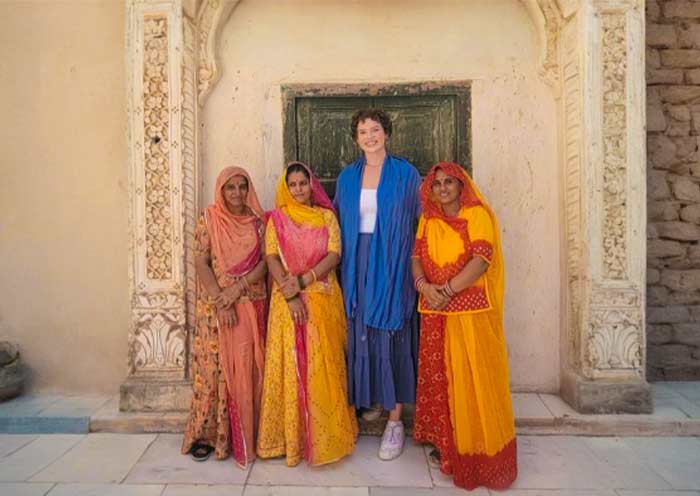
Get ready for an extraordinary adventure in Delhi! Today, you’ll embark on a unique time travel tour, journeying from the majestic Old Delhi steeped in history, all the way to the modern marvels of New Delhi. This exciting exploration will weave together the vibrant tapestry of Delhi, allowing you to witness the city's ancient grandeur seamlessly blend with its contemporary flair.
Your exploration begins in the heart of Old Delhi, where you'll visit Jama Masjid, one of India's largest and most awe-inspiring mosques. Construction began in 1644 under the reign of the Mughal emperor Shah Jahan, the same visionary who brought us the Taj Mahal. This magnificent structure, also known as Masjid-i-Jahan Numa (meaning "mosque commanding the view of the world"), is crafted from red sandstone and adorned with beautiful white marble. Step back into the 17th century and stand in awe under the towering minarets of Jama Masjid. Feel the spiritual energy resonate through time and imagine the grandeur of the Mughal era as the call to prayer echoes through the centuries.
Later, take a stroll to Chandni Chowk, one of the oldest and busiest markets in Old Delhi. Also established by the Shah Jahan in the 17th century, this market is a maze of narrow alleyways filled with small shops offering delectable snacks, sweets, and savories, as well as budget-friendly deals on clothing and other items. Chandni Chowk stretches from the iconic Red Fort to the historic Fatehpuri Masjid, covering a significant distance. To fully immerse yourself in the charm of Old Delhi, we recommend taking an optional rickshaw tour around Chandni Chowk.
Don't miss the opportunity to pass by the Red Fort (World Heritage) and marvel at its symbol of grandeur. Known as Lal Qila and built by the Shah Jahan, the fort serves as the main residence for the Mughal emperors of India and is recognized as a significant architectural masterpiece.
After that, make your way to New Delhi and explore the iconic India Gate. This magnificent memorial is dedicated to the Indian soldiers of World War I. Resembling the Arc de Triomphe in Paris, India Gate stands as a prominent landmark, symbolizing an important chapter in India's history.
As you move forward, you'll have the opportunity to witness the transformation of Delhi into a thriving modern metropolis while also having a chance to take photos of several notable landmarks, including the Rashtrapati Bhavan (Presidential Residence), Parliament House, North Block, and South Block.
Then, you will arrive at Qutub Minar, a UNESCO World Heritage Site and the tallest brick minaret in the world. Standing proudly at an astonishing height of 72.5 meters (238 feet), the Qutub Minar showcases the exquisite craftsmanship of Indo-Islamic architecture. Prepare to be enthralled by the sheer magnificence of this historical masterpiece as you delve into its rich and fascinating history that dates back to the 12th century.
Finally, visit Humayun's Tomb, another jewel in Delhi's crown and a UNESCO World Heritage Site. It holds the distinction of being the first significant example of a Mughal garden tomb. Its breathtaking design and captivating blend of Persian and Indian architectural styles even served as inspiration for the future wonder of the world, the Taj Mahal! Adorned with intricate marble inlays and surrounded by Char Bagh gardens, this red sandstone monument stands as an iconic symbol of Mughal architecture. Stroll through the paradise garden, marvel at the architectural grandeur, and immerse yourself in the captivating love story it holds.
After this amazing tour, you’ll head back your hotel.
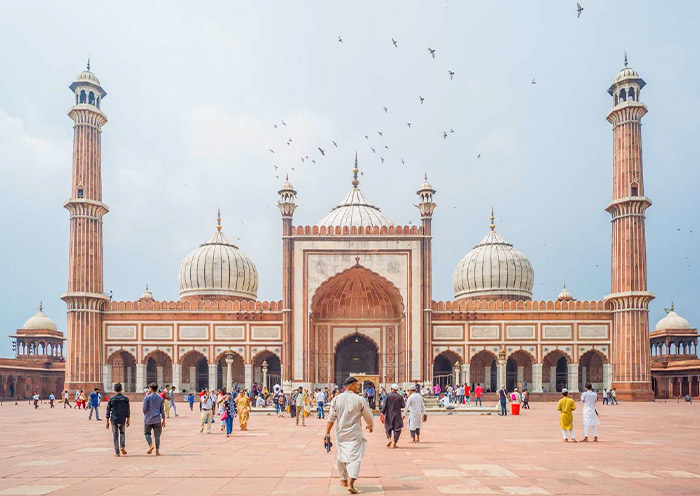



Start your day with a tasty breakfast at your hotel in Delhi and bid farewell to the capital of India in the morning. Head off to Agra, a journey of approximately 250km (155miles) that takes about 4.5 hours, depending on traffic conditions.
The primary route for travel between Delhi and Agra is the Yamuna Expressway. It is known for its well-maintained surface and infrastructure. With our selected vehicle, that's a comfy road trip guaranteed. And it's a scenic road trip as well! Witness the captivating transformation as Delhi's urban sprawl transitions into picturesque landscapes, flyover bridges right over lush green fields, and vibrant agricultural farms painting the landscape. So don't hesitate to ask for a pit stop to capture the essence of the journey with your camera!
Upon arrival in Agra, you can visit Mehtab Bagh for an amazing sunset view. Known as the "Moonlight Garden", Mehtab Bagh is a 16th-century Mughal-era garden that offers a unique perspective of the Taj Mahal, especially during sunset. Watch the iconic Taj Mahal's silhouette reflecting over the calm Yamuna River, creating a truly magical scene. It's a perfect sneak peek preview of the Taj Mahal.
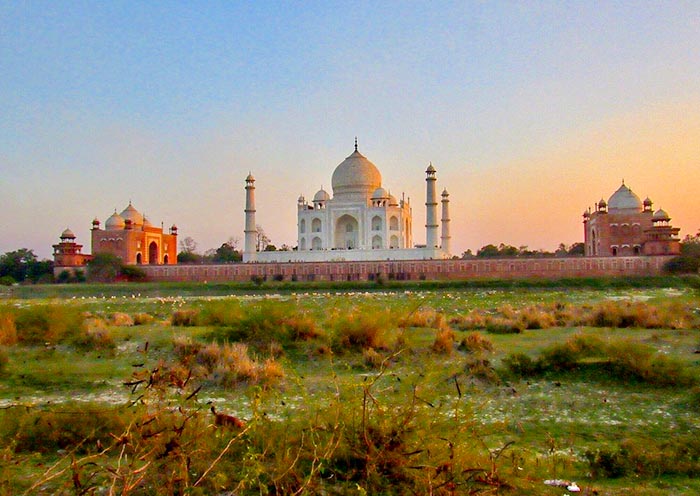
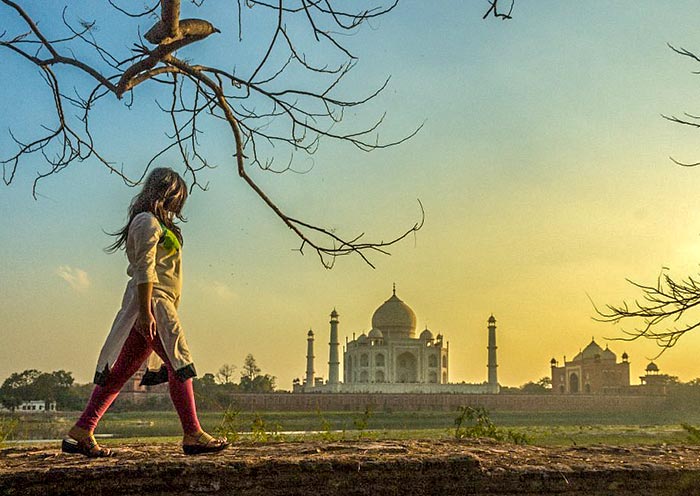
Today will be the big day for the Taj Mahal (World Heritage)! Your knowledgeable guide will pick you up from your hotel in the pre-dawn hours, so you can enjoy a serene sunrise viewing of the Taj Mahal bathed in an ethereal glow, away from the day's heat and crowds.
As you approach the magnificent Taj Mahal, you can admire its immaculate white marble facade glistens in the morning light. This remarkable architectural masterpiece, recognized as one of the New Seven Wonders of the World, serves as an eternal symbol of love. Emperor Shah Jahan built the Taj Mahal in the 17th century as a tribute to his beloved wife, Mumtaz Mahal.
Walking up to the Main Gate of the Taj Mahal is an experience in itself. The gate is carved from red sandstone and adorned with intricate floral patterns. It serves as a grand prelude to the awe-inspiring monument that awaits you. Stepping through, you enter the Charbagh, a formal Mughal garden divided into four perfect quarters by reflecting pools. This symmetry and balance foreshadow the architectural mastery evident in the Tomb itself.
The centerpiece of the Taj Mahal complex is the white marble mausoleum, which houses the cenotaphs of Shah Jahan and Mumtaz Mahal. The story goes that Shah Jahan deliberately built the minarets of the Taj Mahal - towers that serve as vantage points and landmarks - away from and tilted outwards from the main structure. In the unlikely event of a collapse, they would fall away from the Taj Mahal. So the tomb of his beloved wife would remain unharmed. Intricate floral designs, calligraphy, and semi-precious stone inlays that adorn the tomb's surface offer a glimpse into the unparalleled craftsmanship of the era, leaving you breathless with its beauty.
After marveling at the architectural mastery of the Taj Mahal, you will return to your hotel for a refreshing breakfast.
Then, you will continue the journey to Agra Fort (World Heritage). By the way, Shah Jahan was imprisoned in the Agra Fort by his son Aurangzeb. From his vantage point, he is said to have gazed upon the Taj Mahal, which served as a constant reminder of his beloved wife.
Agra Fort is a formidable red sandstone fort built by Emperor Akbar in the 16th century, serving as the seat of Mughal power for nearly a century. Your guide will lead you through the imposing gateways, showcasing the fort's rich history and architectural brilliance. Explore the various palaces, courtyards, and audience halls that once housed emperors, their families, and the Mughal court. Witness the exquisite craftsmanship evident in the intricate carvings, marble inlay work, and jali screens (decorative perforated stonework).
Next, you’ll explore Itmad-ud-Daula's Tomb, also known as the "Baby Taj" which was built by Empress Nur Jahan. This 17th-century mausoleum foreshadows the grandeur of the Taj Mahal with its intricate stone inlay work (perfected later), white marble, and geometric patterns, showcasing the evolving Mughal architectural style. Some might even say that its intricate architectural elements outshine the Taj Mahal!
After the tour, drive back to your hotel in Agra.




Begin your day early with breakfast at your hotel in Agra. Afterward, you will depart from Agra and make your way to Jaipur via Fatehpur Sikri (World Heritage). The journey covers approximately 250km and takes about 5 hours.
En route to Jaipur, make a stop at Fatehpur Sikri, meaning "The City of Victory”, which is 40 kilometers west of Agra. It served as the capital of the Mughal Empire under Emperor Akbar from 1571 to 1585. Visiting Fatehpur Sikri offers a deep dive into India's rich history, providing insight into the life and times of one of its most celebrated emperors, Akbar the Great. It is a prime example of Akbar's architectural genius, dominated by red sandstone buildings, showcasing a unique blend of Hindu, Jain, and Islamic architectural styles, a reflection of the syncretic culture developed under Akbar’s rule.
The city is divided into two main areas: the royal palace complex and the religious complex. The royal complex includes stunning buildings such as the Diwan-i-Aam (Hall of Public Audience), Diwan-i-Khas (Hall of Private Audience), Jodha Bai's Palace, Birbal's House, and Panch Mahal, among others. The religious compound features the Jama Masjid (Grand Mosque) and the tomb of Salim Chisti, a revered Sufi saint, which draws pilgrims from all over due to its sanctity and the belief in the fulfillment of wishes tied to it. One of Fatehpur Sikri’s most iconic structures is the Buland Darwaza (The Gate of Victory), standing at a height of 55 meters. It was erected by Akbar to commemorate his victory over Gujarat and is a magnificent example of Mughal architecture. The gate serves as the main entrance to the Jama Masjid.
Following the tour, drive on to Jaipur, which is approximately 210 kilometers away, taking around 4 hours from Fatehpur Sikri. Welcome to Jaipur, the vibrant capital of Rajasthan, India, known as the "Pink City" for its trademark building color. Jaipur's most striking feature is the rose-colored hue of its buildings in the old city center. his distinctive color scheme is attributed to a welcoming gesture by Maharaja Ram Singh who had the city painted pink in 1876 to honor a visit by the Prince of Wales (later King Edward VII). Upon reaching Jaipur, check in at your hotel and take some time to unwind.
Optional Activity: Jaipur Local Bazaar Walking Tour with a Guide (USD 40 per person).
You have the option to participate in a Jaipur Local Bazaar walking tour with your tour guide. Jaipur is a fantastic shopping destination, with lots of bazaars showcase wonderful Rajasthan artifacts such as textiles, gemstones, silver, and pottery. One local specialty is blue pottery, which features hand-painted vessels adorned with floral motifs and geometric patterns in combinations of blue, white, and occasionally other colors.

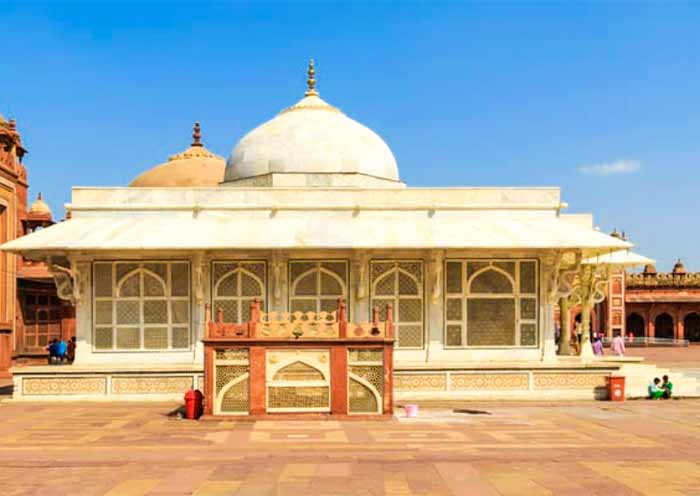
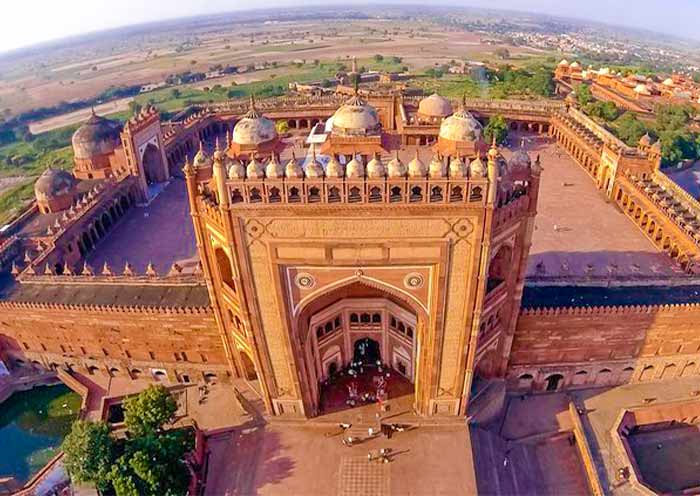

After a delightful breakfast, embark on a full-day Jaipur sightseeing led by your guide, including visits to the magnificent Amber Fort, the City Palace, the Hawa Mahal, and the Jaipur Jantar Mantar.
Your first destination is Amber Fort (World Heritage). The magnificent, formidable, honey-hued fort of Amber is an exquisite example of Rajput architecture. It is located in the rugged hills about 11km northeast of Jaipur, overlooking Maota Lake, and is a must-see sight in the city. Amber was the former capital of Jaipur state. This magnificent fort comprises an extensive palace complex, showcasing a fine blend of Rajput and Mughal architectural styles. It is built from pale yellow and pink sandstone, along with white marble, and features a grand palace, temples, and several ornate gates. Of particular interest is the Sheesh Mahal (Mirror Palace), where the walls are inlaid with exquisite mirrored motifs that dance in the flickering flame of even a single candle.
Tips: You can choose to take a jeep ride (optional) up to the Amber fork rather than take an elephant ride (optional).
You can reach the Amber fort through the Suraj Pol (Sun Gate) which leads to the Jaleb Chowk, the first main courtyard. Diagonally opposite is the Chand Pol (Moon Gate). From Jaleb Chowk, a flight of stairs leads up to the small Siladevi Temple, whose doors feature relief work in silver. The main palace is up next, which includes the Diwan-e-Am (hall for a private audience with the king) with carved columns and latticed galleries, the king’s apartments, the gate Ganesh Pol with beautiful arches, and Jai Mandir or Sheesh Mahal. Stand at one of the many arched windows of the palace and take in the rolling shrubland stretching up to the horizon and the scenic Maota Lake at the foot of the fort.
Next, head to the City Palace, situated in the old city of Jaipur. It is a sprawling complex that blends Rajput and Mughal architecture styles and serves as the royal residence of the Jaipur royal family. The palace houses several buildings, including Chandra Mahal, the Armoury, Diwan-i-Khas, and Diwan-i-Am Art Gallery, along with courtyards and gardens. Among them, Pitam Niwas Chowk (Courtyard of Love) is a photographer's delight. It is famous for its 4 colored gates, each representing a different season. The Peacock Gate depicts autumn, the Lotus Gate signifies summer, the Green Gate represents spring, and finally, the Rose Gate embodies winter.
No tour would be complete without visiting Hawa Mahal (Palace of Winds). It is renowned for its unique 5-story exterior, resembling the honeycomb of a beehive. This architectural wonder is built of red and pink sandstone, and features an incredible 953 intricately carved windows. These windows, resembling a honeycomb design, gave the building its name ("hawa" meaning "wind" in Hindi) and allowed royal ladies to observe everyday life and festivals in the street below without being seen. The clever design also facilitate the circulation of cool breezes throughout the palace, providing natural air conditioning, especially during the hot summer months. Hawa Mahal is an architectural marvel that blends Hindu Rajput architecture with Islamic Mughal architecture. The facade of Hawa Mahal is a stunning sight, particularly when bathed in the golden light of the early morning or late afternoon.
Immediately behind the Hawa Mahal is the Jaipur Jantar Mantar (World Heritage), considered one of the oldest astronomical observatories in the world, built by Maharaja Sawai Jai Singh II. The observatory houses the world's largest stone sundial and features 16 devices designated to measure time, observe planetary motion around the sun, and keep track of celestial bodies. The geometric devices of the observatory are both functional and architecturally fascinating, offering a glimpse into the advanced astronomy studies of the 18th century.

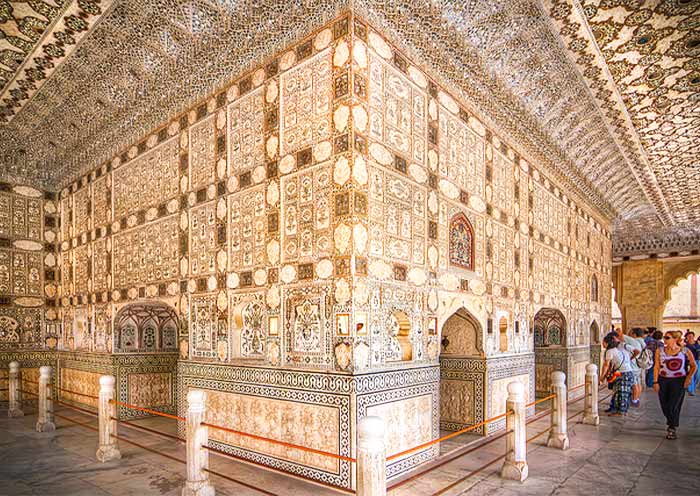


Today you will drive back to Delhi (290km, about 6 hours) via private car and you will then be transferred to the Indira Gandhi International Airport to catch your flight to Sri Lanka.
Welcome to Sri Lanka, the “Pearl of the Indian Ocean”! When you arrive at Bandaranaike International Airport, you will get your first taste of warm Sri Lankan hospitality. Our chauffeur-guide will welcome you at the airport and then drive to your hotel in Negombo, a seaside town that is only 20 minutes away from the airport. After checking in at your hotel, you can take a sunset stroll along this west coast beach.
Negombo is a significant city on the western coast of Sri Lanka, known for its beautiful beaches, rich history as a fishing village, and its convenient location just 10 kilometers from the Bandaranaike International Airport. The City is a favored stop for many tourists either arriving in or departing from Sri Lanka.

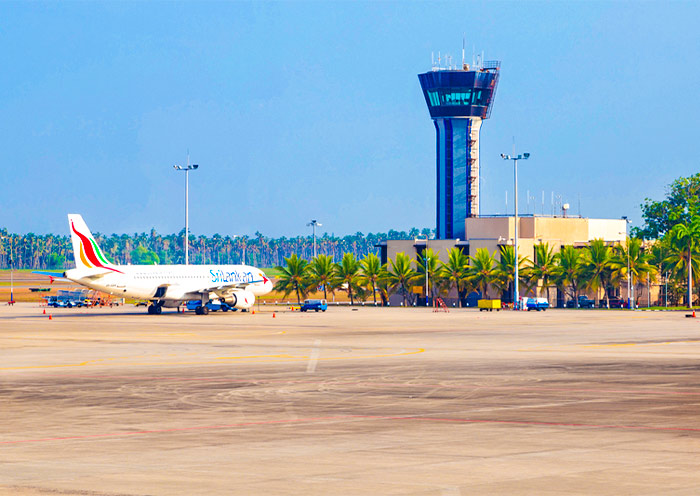

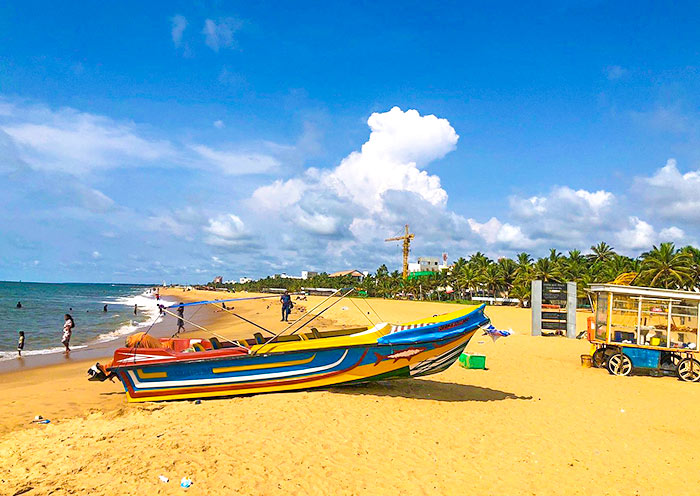
After breakfast at your hotel, you'll journey to Sigiriya, with an enriching stop at the Pinnawala Elephant Orphanage, and culminates in a peaceful overnight stay in Dambulla (Approximately 4.5 hrs ride).
Firstly, you will drive about 2 hours to visit the Pinnawala Elephant Orphanage. The orphanage is home to the largest herd of captive elephants in the world. It mainly adopts young elephants that are homeless, fell into pits or traps, separated from the herd, especially those who were seriously injured. The elephants at Pinnawala are provided with a natural habitat to roam freely during the day. Twice a day, a unique and heartwarming spectacle occurs when the elephants are taken in a procession to the nearby river to bathe. This bathing ritual is a favorite among visitors, offering an intimate glimpse into the social behaviors and playful interactions of the elephants.
The journey continues towards Sigiriya (Approximately 2.5 hours). The ancient city of Sigiriya designated a cultural World Heritage Site in 1982, is a top world attraction. It is considered an eighth wonder of the world - along with the Grand Canyon and Ancient Pyramids - and you will understand why once you visit here. The first thing that captures your attention is the massive rock stands at a height of approximately 200 meters (660 feet) rising dramatically from the lush greenery of the surrounding landscape.
Sigiriya Rock Fortress, or Lion Rock is an ancient palace and fortress complex in the air built on a huge orange rock, indeed the “rock-star” attraction of Sri Lanka. It is said the residence of King Kasyapa. At first, the giant rock was built to look like a huge lion, but now the lion's head has weathered and fallen off, leaving only the lion's body. The climb to the top of Lion Rock is an exhilarating adventure in itself. The base of the rock is surrounded by a moat, rampart, and extensive gardens, including mid-water gardens. To reach the top, you'll need to navigate a series of staircases attached to sheer walls, bringing you closer to the heart of this ancient complex.
Along the path, you'll see the famous frescoes and vibrant paintings that depict celestial maidens. Another highlight is the Mirror Wall, originally polished so the king could see his reflection as he passed. Today, it's covered in inscriptions and poems left by past visitors. The final ascent to the summit is marked by colossal lion’s paws carved into the bedrock. The summit houses the ruins of the palace, surrounded by remnants of sophisticated urban planning, including more moats, gardens, and cave shrines. Here, you can feel the echoes of the past. Reaching the summit rewards you not only with the ruins of a once-grand palace but also with an epic view of the landscape at sunset.
Travel Tips:
1. Hike and Timing: The hike to Sigiriya Rock Fortress typically takes about 2 to 3 hours, depending on your physical fitness level and the crowd size on the day of your visit.
2. Wear Comfortable Clothing. Opt for light, comfortable clothing and sturdy shoes as the climb involves steep staircases and uneven surfaces.
3. Bring Water and Essentials: Bring plenty of water to stay hydrated. Also, remember to bring a hat, sunscreen, and sunglasses. It can get very hot, especially during the climb.
4. Hire a site Guide: Consider hiring a guide at the entrance if you're interested in learning more about the history and significance of Sigiriya. Guides can provide insights that enrich your experience.
After the tour, proceed to Dambulla for an overnight stay.
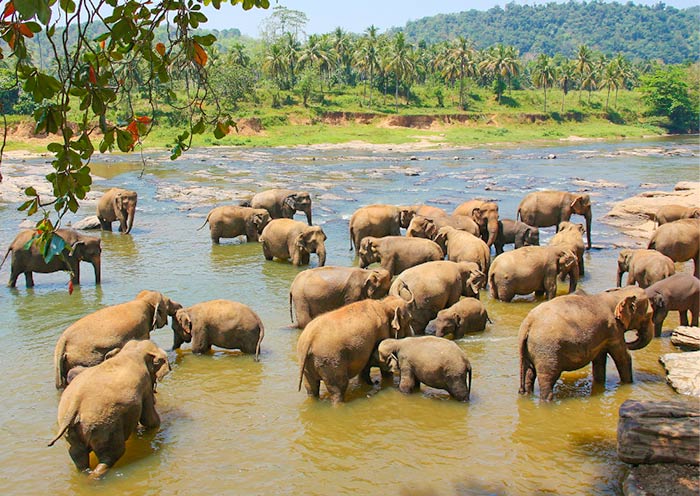



After breakfast at your hotel, you will explore the UNESCO World Heritage-listed Dambulla Cave Monastery, also known as the Golden Temple of Dambulla, renowned for its spectacular rock paintings and statues dating back to the 1st century BCE. Wander through the five main caves, each cave has its unique character, filled with Buddhist murals that depict various aspects of the Buddha's life and teachings, along with statues in various poses (Mudras) that represent different philosophical meanings in Buddhism. Moreover, it also offers superb views over the surrounding countryside.
Then, you will proceed to Kandy, the blessed city (Approximately 2.5 hours). En-route visit Spice Garden. This garden is a delightful stop. For centuries spices have been one of Sri Lanka's most celebrated exports. Spices such as cinnamon, ginger, vanilla, pepper, and cardamom are grown in home gardens as home industries and used not only to flavor food but also as home remedies. Most tourists find this tour highly enjoyable and educational.
Upon arrival in Kandy, check into your hotel and take some time to rest and refresh. Evening witness the traditional Kandyan Dance Performance accompanied by tumultuous drumming. Dances include the cobra dance, mask dance, and the Ginisisila, showing power over fire. The dancers wear elaborate costumes including a headdress, their chests only covered by a decorative beaded net. The entire frenetic and colorful spectacle climaxes with the amazing fire-walking act. Note: The cultural show is on stage from 5.00 pm - 6.00 pm.




Surrounded by a beautiful lake and backed by a forested halo of misty hills, the Sacred city of Kandy is not just a UNESCO World Heritage site, but also a cultural capital of the island, home to the Temple of the Tooth, the country’s most important religious shrine, and the Esala Perahera, its most exuberant festival.
Your exploration starts at the sacred Temple of the Tooth, or Temple of the Sacred Tooth Relic (Sri Dalada Maligawa), one of the most revered sites in Buddhism. This majestic temple houses the Tooth Relic of the Buddha, making it a pivotal center of faith and pilgrimage. The temple complex is a beautiful example of Kandyan architecture, with a distinctive white facade and a roof covered in gold tiles. The interior of the temple is richly decorated with murals, sculptures, and carvings. As you walk through its richly decorated halls and chambers, you'll feel the spiritual aura and historical significance that have enveloped this place for centuries. Tips: To enter the temple premises Women are required to wear long sleeves and skirts or pants to the ankles; men are required to wear long pants and also must remove, a scarf, Hats, and Slipper.
Good to Know:
1. The Theva ceremonies (Offering Ceremony) conduct daily worship in the inner chamber of the temple at midday (around 9:30 AM), and dusk (around 6:30 PM).
2. The Nanumura Mangallaya(Holy Water Ceremony) is the ritual bathing of the Tooth Relic that occurs on Wednesdays.
3. The Esala Perahera (The Festival of the Tooth) is the most spectacular event associated with the Temple of the Tooth, held annually in July or August.
Next, you'll visit the Royal Palace of Kandy, adjacent to the Temple of the Tooth. Kandy served as the capital of the last Sinhalese kingdom. This former residence of the Kandyan monarchs now stands as a testament to the city's regal past. Exploring its well-preserved structures, you'll discover the palace's intricate architecture and get a glimpse into the lifestyle of Sri Lankan royalty. The complex also hosts several museums, offering insights into the rich cultural heritage of Kandy.
Your journey continues to the Royal Botanical Gardens in Peradeniya, just a short drive from Kandy. Spread over 147 acres, these gardens are a haven of tranquility and a showcase of botanical diversity, including more than 4000 species of plants. The orchid collection and the majestic avenue of royal palms are just some of the highlights. The gardens' lush landscapes and serene ambiance provide a peaceful retreat and an opportunity to marvel at nature's splendor.
Lastly, you will have a leisurely walk around beautiful Kandy Lake, a man-made lake in the heart of the city. Built-in 1807 by King Sri Wickrama Rajasinghe, the lake offers picturesque views and a calming atmosphere. The lakeside path, with its tranquil waters on one side and the city's historic landmarks on the other.
Stay overnight in Kandy.




Today, you'll depart Kandy and drive to Nuwara Eliya (Approximately 2.5-3 hours), a picturesque journey packed with beautiful waterfalls, tea plantations, and picturesque mountain ranges. On the way stop at the cascading Ramboda Waterfall and and take some photos.
Nearing Nuwara Eliya,you'll find yourself enveloped in its cool, crisp climate - a stark contrast to the tropical warmth you've left behind. Standing at 6,200 feet above sea level, this cool climate makes it the perfect environment for tea cultivation, earning it the title of the Hill Country’s “tea capital,” a title that endures.
Along the way, you'll be escorted to a tea plantation, where the world’s best Ceylon Tea is produced. Wander through the verdant tea fields, observing the skilled tea pickers at work, selecting the finest leaves with precision. The visit typically includes a tour of the tea factory, where you'll learn about the fermentation, drying, cutting, and grading processes that transform green tea leaves into fragrant tea enjoyed worldwide. Don't forget to sip a cup of pure Ceylon tea in the factory and continue to "Little England" town.
Upon arriving in Nuwara Eliya, you'll sense a faint British country village ambiance with its colonial-era bungalows, Tudor-style hotels, well-kept hedgerows, and charming gardens. Once colonized by the British and often referred to as "Little England," Nuwara Eliya maintains its old-world charm.
Concluding your day at Gregory Lake allows for a gentle deceleration, with the serene waters and recreational activities offering a perfect backdrop for relaxation and reflection.
Stay overnight in Nuwara Eliya.

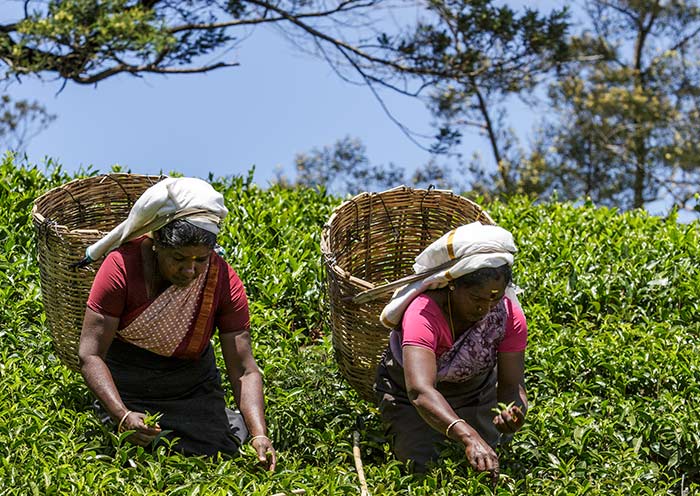


After an early breakfast, set off on a hiking trip to Horton Plains National Park. Horton Plains belongs to the Central Highlands of Sri Lanka and is a World Heritage Site declared by UNESCO. The plains are over 2000m high and are covered by wild grasslands and interspersed with patches of thick forest, rocky outcrops, waterfalls, and lakes. Horton Plains is the only national park in Sri Lanka where visitors are allowed to hike on their own. It provides some excellent trails for hikes amongst the shadows of its dewy foliage and misty landscapes. The surprising diversity of the landscape is matched by the wide variety of wildlife. If you're lucky, you may spot herds of sambar deer, leopards, or a wild boar during your hike. Birdwatchers will be richly rewarded.
Special Notes:
1. The circular trail to World's End is approximately 9 km and takes around 3 to 4 hours to complete. You can choose where to end based on your physical strength.
2. We will use a jeep or van due to the narrow roads toward Horton Plains National Park
3. It is recommended to start from Nuwara Eliya city around 6.00 - 6.30 am to make the most of the clear views and to avoid the heat of the day.
4. Today most probably we will have a packed breakfast.
5. It is advisable to wear comfortable hiking shoes and dress in layers to adjust to the changing temperatures.
After your morning hike, head to Nanu Oya Railway Station, which is about 8 km from Nuwara Eliya, to catch your scenic train to Ella. Considered one of the most spectacular rail journeys on earth, this stretch of track winds through the cool and misty valleys of the Hill Country, passing lush tea plantations, dramatic waterfalls, and green fields dotted with tea pickers draped in brightly-colored saris.
Tips for Train:
1. Train Tickets are hot, especially in the high season. It is advisable to book one month before your traveling date.
2. Keep in mind that tickets are subject to availability, and you may not be able to choose specific seats.
3. In the event of train delays or cancellations, be aware that the ticket fee is non-refundable.
4. The journey from Nanu Oya to Ella typically takes between 3 to 4 hours, depending on the specific train service and any delays along the route.
5. Sri Lankan trains are not known for their strict schedules. Delays are common, so be prepared to relax and enjoy the ride!The journey itself is part of the experience.
Upon arrival at Ella Railway Station, you will be picked up by your chauffeur guide, and drive to visit the Nine Arch Bridge in Ella. This architectural marvel spans 91 meters at a height of 2 m, constructed entirely from bricks, rocks, and cement (without the use of steel), and stands amidst lush jungle and tea fields. The train's approach to this bridge is a moment many passengers eagerly await, ready with their cameras.
After exploring Ella, you'll drive to Tissamaharama, approximately 2 hours away. This town serves as your base for the upcoming safari adventures in Yala National Park. Upon arrival check in to your lovely hotel and relax.




Your day starts early with a thrilling Jeep safari in Yala National Park, one of the most visited and second-largest national parks in Sri Lanka. Known for its high density of leopards, Yala offers an unparalleled wildlife viewing experience.
The Jeep safari kicks off around 6:30 am, allowing you to witness the park as it awakens. This timing increases your chances of seeing animals when they are most active. Spend approximately 2.5 to 3 hours exploring Yala in a private safari Jeep. Keep your cameras ready for potential sightings of leopards, elephants, sloth bears, and a variety of birds.
Wildlife Spotting:
Leopards: Yala's reputation for leopard sightings is unparalleled, particularly in Block 1, where the density of these majestic creatures is among the highest globally. Panthera pardus kotiya, the subspecies you may well see, is unique to Sri Lanka.
Birdwatching: With over 200 bird species, Yala is a birdwatcher's paradise, hosting migratory visitors like white-winged black terns and residents including peacocks and hornbills.
Elephants and Other Animals: The park’s estimated 300 elephants can be more elusive, although some regularly appear in the most visited areas. Other animals of note include the shaggy-coated sloth bear and fox-like jackals. Sambars, spotted deer, boars, buffaloes, mongooses, and monkeys are also here, along with startlingly large crocodiles.
Tips for Yala National Park:
1. Yala National Park is divided into 5 blocks. Block 1 (mainly around the Palatupana entrance) is the most popular zone for safaris and has the highest leopard concentration.
2. There are generally two sessions for jeep safaris - morning and afternoon. Morning safaris from 6:30 AM, offering cooler temperatures and active wildlife. Afternoon safaris (starting from 2:30 PM) capture the golden light before sunset, ideal for photography.
3. The best times for wildlife viewing in Yala are during the dry season from February to June when animals are more likely to be seen near water sources. The park is sometimes closed for a brief period around August and September for maintenance.
4. Each jeep has a total of six seats, including the seat of guide or driver.
5. Pack a pair of binoculars for better wildlife viewing, a camera with a good zoom lens.4. Each jeep has a total of six seats, including the seat of guide or driver.
6. While wildlife sightings are never guaranteed due to the elusive nature of wild animals, your guide will use their expertise to track animals and enhance your chances of a memorable encounter.
After immersing yourself in the natural wonders of Yala, your journey continues to Galle, a port city steeped in history with its well-preserved Dutch Fort, a UNESCO World Heritage site. Along the way, consider stopping at one of the iconic stilt fishing spots to witness this unique fishing method firsthand. The picturesque scene features fishermen perched on slender poles above the water. These stilts enable the fishermen to see further out into the water and cast their lines into deeper areas. The best times are early in the morning or late in the afternoon.
The main attraction of Galle no doubt is its ancient Galle Fort, which instantaneously takes visitors back to the Dutch Colonial era. Walking through the narrow streets of the fort, you'll encounter an array of heritage buildings, including Dutch churches, grand mansions, museums, and historic mosques. The fort's ramparts offer stunning views of the Indian Ocean, especially at sunset.
Stay overnight in Galle.



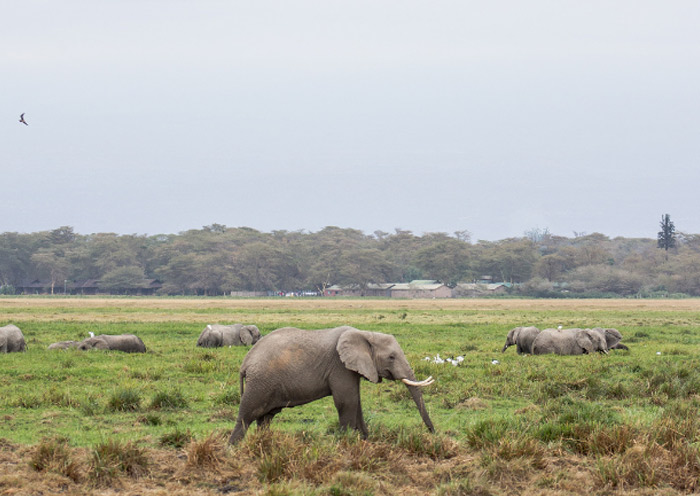
After breakfast, embark on a scenic drive to Bentota, renowned for its broad golden beaches and crystal-clear waters. The journey offers picturesque views of the coastline and takes approximately 1 to 1.5 hours.
Spend your day at leisure on Bentota Beach, one of Sri Lanka's most beautiful beaches. Whether you're interested in water sports, such as jet skiing, windsurfing, and banana boat rides, or simply looking to relax on the sand and soak up the sun, Bentota offers a perfect setting. The beach is well-equipped with facilities and surrounded by lush greenery, adding to its appeal.
Special Note:
- Vehicle & driver will NOT be your disposal during the beach stay.
- All water sports activities will be at your own expense.
Stay overnight in Bentota.




Today, you'll driven from Bentota to Bandaranaike International Airport for your departure. The drive takes approximately 1.5 to 2 hours. Depending on your flight schedule, you may have some time in the morning to enjoy a final stroll along the beach or a leisurely breakfast at your hotel. Ensure you arrive at the airport at least 2 hours before your international departure to complete check-in and immigration procedures.
Coastline Train Experience (Optional)
For a scenic return to Colombo, consider taking the coastal train. The train hugs the coastline for a significant portion of the journey, providing uninterrupted views of the Indian Ocean's azure waters. This optional activity is subject to availability and train schedules.
It is time to end your 15 Days India Sri Lanka Tour. If you wish to extend your stay in Colombo for another night, please feel free to ask us to arrange accommodation for you. If you prefer to travel longer in Sri Lanka, you can extend your trip to other highlighted parts of Udawalawe, Mirissa, Anuradhapura, Polonnaruwa, etc.
Thank you for choosing Asia Odyssey Travel for your Asia tour, we are always here working for you and hope to see you again for your next trip to Asia. Safe journey!


Price: What’s Included & What’s Excluded
What's Included:
What's Excluded:
Important Travel Tips for Visiting Sri Lanka
Before your trip, it is important to check the visa requirements for Sri Lanka and ensure that you have all the necessary documents.
For the West and South Coasts and Hill Country: The ideal time to visit these areas is from December to March.
During these months, the weather is dry and sunny, making it perfect for exploring the beaches and the central
highlands.
For the East Coast: The best months to visit are from April to September. This period avoids the Yala monsoon,
which affects the southwest part of the island and brings rain primarily from May to August.
Generally, the roads between the tourist cities are well-developed and maintained, offering a smooth driving experience. These areas have better-maintained roads and traffic management systems, though traffic congestion can be a significant issue, especially during rush hours.In more rural and remote areas, road conditions can deteriorate. Roads might be narrower, less maintained, and sometimes unpaved. In the hill country, roads can be winding and steep. While the views can be stunning, driving in these areas requires caution, especially in adverse weather conditions.
1.Religious Respect: Sri Lanka is home to many religious traditions, including Buddhism, Hinduism, Islam, and Christianity. It's important to dress modestly and remove shoes when entering temples and other religious sites. Covering shoulders and legs is generally expected. Observing and respecting religious rituals and festivals is appreciated.
2.Greetings: The traditional greeting in Sri Lanka is the "Ayubowan," which means "may you have a long life." It is usually accompanied by a slight bow and hands placed together in a prayer-like gesture. While handshakes are also common, especially in formal settings, it's best to wait for the other person to offer their hand first.
3. Hospitality: Sri Lankans are known for their hospitality. It's common to be offered tea or a meal when visiting someone's home. It is polite to accept at least a small amount of what is offered, as refusing can sometimes be considered impolite.
4. Dining Etiquette: When eating, especially in a home or traditional setting, it's customary to use your right hand rather than utensils. This applies particularly to local dishes such as rice and curry. Washing hands before and after meals is also a common practice.
5. Dress Code: Dressing conservatively is advised, particularly when outside urban centers. Women should avoid wearing revealing clothing, and both men and women should consider covering legs and shoulders, especially when visiting religious sites.
6. Photography: Always ask for permission before taking photos of people, particularly in rural areas. This is also important at religious sites, where photography might be restricted or considered disrespectful in certain areas.
Hotel Conditions for Your Sri Lanka Tour




To cater to various travelers' preferences and budgets, we offer a range of carefully chosen accommodations, including luxurious 5-star hotels, comfortable 4-star options, and economical 3-star establishments.
Find your perfect hotel according to difference needs: There is a growing number of boutique hotels throughout the island, offering unique and personalized experiences. These are often located in scenic areas such as the hill country or along the coast. For those interested in nature and sustainable travel, eco lodges and adventure camps are available, especially near wildlife parks and in remote areas. You can offer stays in colonial-era buildings that have been converted into hotels. These are often found in the hill country and coastal areas.
Photo Gallery for This Itinerary
Latest Sri Lanka Tours Reviews from Our Customers

Alina
Singapore
Date of Experience: Feb 15, 2024
Tour Customized by: Cici
You May be Interested in This Tour: 7 Day Sri Lanka Essence Tour: Heritage, Tea, Safari in One Week

Anna
America
As newlyweds embarking on our much-awaited honeymoon, we entrusted our dreams to Asia Odyssey Travel, and they certainly didn't disappoint. Over the course of 10 enchanting days, we were swept away on a journey that surpassed all our expectations, creating memories to cherish for a lifetime.
Highlights of the trip include visiting the ancient city of Kandy and climbing Sigiriya Rock, both of which are unique and impressive experiences. The sacred Buddhist sites in Kandy and the majestic views from Sigiriya Rock perfectly blend culture with nature. Additionally, the honeymoon package includes leisure time on private beaches, seamlessly incorporating elements of romance and relaxation.
The choice of hotels is very elegant, especially the resorts by the sea, which provide an intimate and private setting. The cuisine is another highlight, featuring authentic Sri Lankan dishes as well as options suited for international palates.
In terms of service, the team at Asia Odyssey Travel demonstrates great professionalism and care. From planning the itinerary to every detail during the actual trip, they ensure everything runs smoothly. The guides are very knowledgeable about the local culture and history, providing rich information and stories that enhance the educational and entertaining aspects of the trip.
Overall, this honeymoon tour is a dreamlike experience for newlyweds, perfectly blending adventure, culture, relaxation, and romance. If you're looking for a special honeymoon destination, the Sri Lanka itinerary by Asia Odyssey Travel is definitely worth considering.
Date of Experience: Nov 12, 2023
Tour Customized by: Kyle
You May be Interested in This Tour: 10 Days Sri Lanka Family Tour with Kids: Educational Family Adventures
Price: Request
(Based on a private tour for two people. Price varies depending on program, travel date, number of people.)
Free Enquiry! You don’t need to pay for the reservation.
- United States (+1)
- Australia (+61)
- Singapore (+65)
- Malaysia (+60)
- Philippines (+63)
- Canada (+1)
- Italy (+39)
- Indonesia (+62)
- United Kingdom (+44)
- Spain (+34)
- Mexico (+52)
- Hong Kong (+852)
- Thailand (+66)
- United Arab Emirates (+971)
- New Zealand (+64)
- South Africa (+27)
- Germany (+49)
- Brazil (+55)
- India (+91)
- France (+33)
- Vietnam (+84)
- The Netherlands (+31)
- Saudi Arabia (+966)
- Ireland (+353)
- Argentina (+54)
- Switzerland (+41)
- Romania (+40)
- Pakistan (+92)
- Japan (+81)
- Portugal (+351)
- Bangladesh (+880)
- South Korea (+82)
- Puerto Rico (+1)
- Türkiye (+90)
- China (+86)
- Belgium (+32)
- Qatar (+974)
- Greece (+30)
- Taiwan (+886)
- Austria (+43)
- Poland (+48)
- Israel (+972)
- Chile (+56)
- Sri Lanka (+94)
- Nigeria (+234)
- Peru (+51)
- Colombia (+57)
- Hungary (+36)
- Nepal (+977)
- Denmark (+45)
- Bulgaria (+359)
- Norway (+47)
- Slovenia (+383)
- Sweden (+46)
- Kuwait (+965)
- Costa Rica (+506)
- Ecuador (+593)
- Venezuela (+58)
- Malta (+356)
- Croatia (+385)
- Tunisia (+216)
- Czechia (+420)
- Mongolia (+976)
- Bahrain (+973)
- Mauritius (+230)
- Papua New Guinea (+675)
- Cambodia (+855)
- Dominican Republic (+1)
- Luxembourg (+352)
- Finland (+358)
- Guatemala (+502)
- Myanmar (+95)
- Maldives (+960)
- Slovakia (+421)
- Laos (+856)
- Serbia (+381)
- Brunei (+673)
- Oman (+968)
- Macao (+853)
- Panama (+507)
- Morocco (+212)
- Jordan (+962)
- Georgia (+995)
- Fiji (+679)
- Bolivia (+591)
- Lithuania (+370)
- Bahamas (+1)
- Cyprus (+357)
- Latvia (+371)
- Bhutan (+975)
- Iraq (+964)
- Iran (+98)
- Kenya (+254)
- Jamaica (+1)
- Zimbabwe (+263)
- Azerbaijan (+994)
- Uruguay (+598)
- Estonia (+372)
- Andorra (+376)
- Cameroon (+237)
- Ghana (+233)
- Kazakhstan (+7)
- Nicaragua (+505)
- Egypt (+20)
- Russia (+7)
- Albania (+355)
- Réunion (+262)
- Montenegro (+382)
- Algeria (+213)
- Afghanistan (+93)
- Martinique (+596)
- Uganda (+256)
- Honduras (+504)
- North Macedonia (+389)
- Trinidad and Tobago (+1)
- Suriname (+597)
- Antigua and Barbuda (+1)
- Zambia (+260)
- Ukraine (+380)
- Armenia (+374)
- Barbados (+1)
- Belarus (+375)
- Palestine (+970)
- Lesotho (+266)
- Moldova (+373)
- Ethiopia (+251)
- French Polynesia (+689)
- Gambia (+220)
- Guam (+1)
- Gibraltar (+350)
- Isle of Man (+44)
- New Caledonia (+687)
- El Salvador (+503)
- Comoros (+269)
- Seychelles (+248)
- Chad (+235)
- Samoa (+685)
- Cook Islands (+682)
- Palau (+680)
- Paraguay (+595)
- DR Congo (+243)
- Solomon Islands (+677)
